The potential of Artificial Intelligence (AI) to transform conventional learning environments is still developing as we approach 2024. Large Language Models are leading this shift. With their individualized learning, intelligent tutoring systems, and plethora of other revolutionary uses, these advanced AI models are expected to be essential in improving educational experiences. We shall examine in this post how LLMs are influencing education in the future.
Recognition List of LLMs
Highly developed artificial intelligence systems called Large Language Models (LLMs) are made to comprehend and produce human language. Like the learning processes of the human brain, they run on neural networks. These algorithms pick up the subtleties of language by analyzing enormous text datasets, which allows them to produce logical answers and understand the background of talks. LLMs are therefore especially well-suited for a variety of educational uses, including content production and individualized instruction.
Top 2024 LLM Educational Applications
Personalized Learning
Personalized learning is one of the most powerful ways that LLMs are used in the classroom. LLMs can customize course material to suit the particular requirements of each student. These models are able to modify the level of difficulty and kind of material provided by evaluating a student’s progress and learning style, therefore guaranteeing that every student has a personalized learning experience. This customization contributes to the resolution of the particular difficulties encountered by every learner, therefore improving learning results generally.
Support and Tutoring
Artificial intelligence tutoring systems driven by LLMs are revolutionizing the field of educational support. In real time, these technologies answer questions and clarify difficult ideas to pupils on demand. LLMs can provide explanations and clarifications that change to the students’ comprehension level by mimicking the interactive quality of a human teacher. This technology guarantees that students have access to ongoing support in addition to supplementing classroom instruction, therefore creating a more complete and robust learning environment.

Create Educational Content
The time and work needed to produce instructional content can be greatly cut down with LLMs. Among the many educational resources that these models can produce are textbooks, lesson plans, and tests. LLMs let educators quickly create excellent content so they can concentrate more on teaching and less on preparing materials. LLMs guarantee that instructional material is up to date and pertinent by automating the production of resources, therefore keeping up with the changing educational standards.
Learning and Translation of Languages
Regarding language learning, LLMs provide students with unmatched chances to hone and polish their abilities. These models facilitate students’ learning of new languages by offering real-time translation and language assistance. Immersion language learning is created by LLMs’ ability to mimic conversations, correct grammar, and offer quick feedback. Students learning in multicultural settings especially benefit from this ability since it helps them overcome linguistic obstacles and become fluent.
Examine and Comment
Automating the assessment process is made possible in large part by LLMs. They have remarkably good accuracy in grading, qualitative feedback, and response analysis from students. Personalized student interactions can take up a lot of time that educators can save by automating repetitive grading chores. LLMs can also give thorough analysis of student performance, pointing up areas of strength and weakness and enabling a more data-driven approach to teaching.

Improvement of Educational Accessibility
The ability of LLMs to democratize learning is a major benefit in education. These strategies provide high-quality education independent of location by making educational resources more available to underprivileged areas. LLMs can provide scalable educational solutions that guarantee students from different origins have access to the same excellent material and assistance. Launched by LLMs, initiatives can close educational gaps and provide a more fair and inclusive learning environment.
Notes Consequence
Looking ahead, the use of LLMs into education is clearly a revolutionary force. LLMs offer creative answers to the changing demands of contemporary education by improving individualized learning, simplifying content creation, and automating evaluation procedures. Exciting developments are predicted for this year, and the broad use of LLMs may completely change the educational scene by enabling more individualized, effective, and accessible learning than before. Reaching the full potential of AI in education will need accepting these developments.





